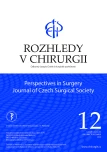PIPAC – overview of the method and first use in the Czech Republic
Authors:
D. Hoskovec 1; Z. Krška 1; M. Vočka 2; P. Dytrych 1
Authors‘ workplace:
I. chirurgická klinika 1. lékařské fakulty Univerzity Karlovy a Všeobecná fakultní nemocnice v Praze
1; Onkologická klinika 1. lékařské fakulty Univerzity Karlovy a Všeobecná fakultní nemocnice v Praze
2
Published in:
Rozhl. Chir., 2020, roč. 99, č. 12, s. 529-533.
Category:
Review
Overview
PIPAC is a new technique for intra-abdominal administration of aerosol chemotherapy in a gaseous environment (capnoperitoneum). It can be indicated for peritoneal spread of various origins, most commonly ovarian cancer, stomach cancer and colorectal cancer. Due to its mini-invasiveness, the application can be repeated.
The article provides a brief overview of current views of PIPAC and describes the first experience with PIPAC in the Czech Republic.
Keywords:
peritoneal carcinomatosis – PIPAC – HIPEC
Sources
- Krška Z, Hoskovec D, Petruželka L. Chirurgická onkologie. Praha, Grada 2014. ISBN: 978-80-247-4284-7.
- Solass W, Kerb R, Mürdter T, et al. Intraperitoneal chemotherapy of peritoneal carcinomatosis using pressurized aerosol as an alternative to liquid solution: first evidence for efficacy. Ann Surg Oncol. 2014;21(2):553–559. doi: 10.1245/s10434-013-3213-1.
- Nowacki M, Zegarski W: The scientific report from the first pressurized intraperitoneal aerosol chemotherapy (PIPAC) procedures performed in the eastern part of Central Europe. J Int Med Res. 2018;46(9):3748–3758. doi: 10.1177/0300060518778637.
- Katdare N, Prabhu R, Mishra S, et al. Pressurized Intraperitoneal Aerosol Chemotherapy (PIPAC): Initial experience from Indian centers and a review of literature. Indian J Surg Oncol. 2019;10(1):24–30. doi: 10.1007/s13193-018-0771-5.
- Ndaw S, Hanser O, Kenepekian V, et al. Occupational exposure to platinum drugs during intraperitoneal chemotherapy. Biomonitoring and surface contamination. Toxicol Lett. 2018;298 : 171–176. doi: 10.1016/j.toxlet.2018.05.031.
- Alyami M, Hübner M, Grass F, et al. Pressurised intraperitoneal aerosol chemotherapy: rationale, evidence, and potential indications. Lancet Oncol. 2019;20(7):e368–e377. doi: 10.1016/S1470-2045(19)30318-3.
- Alyami M, Mercier F, Siebert M, et al. Unresectable peritoneal metastasis treated by pressurized intraperitoneal aerosol chemotherapy (PIPAC) leading to cytoreductive surgery and hyperthermic intraperitoneal chemotherapy. Eur J Surg Oncol. 2019 pii: S0748–7983(19)30522-0. doi: 10.1016/j.ejso.2019.06.028. [Epub ahead of print].
- Solass W, et al. Peritoneal sampling and histological assessment of therapeutic response in peritoneal metastasis: proposal of the Peritoneal Regression Grading Score (PRGS). Pleura and Peritoneum 2016;1,2 : 99–107. doi:10.1515/pp-2016-0011.
- Nadiradze G, Horvath P, Sautkin Y, et al. Overcoming drug resistance by taking advantage of physical principles: Pressurized Intraperitoneal Aerosol Chemotherapy (PIPAC). Cancers (Basel) 2019;12(1). pii: E34. doi: 10.3390/cancers12010034.
- https://www.technischweekblad.nl/nieuws/injectiemotor-voor-de-ok.
Labels
Surgery Orthopaedics Trauma surgeryArticle was published in
Perspectives in Surgery

2020 Issue 12
- Metamizole at a Glance and in Practice – Effective Non-Opioid Analgesic for All Ages
- Metamizole in perioperative treatment in children under 14 years – results of a questionnaire survey from practice
- Possibilities of Using Metamizole in the Treatment of Acute Primary Headaches
Most read in this issue
- PIPAC – overview of the method and first use in the Czech Republic
- Anus perinei ventralis in adulthood – case report
- Transfemoral amputation for infected secondary lymphoedema – a case report
- Začátky mladého chirurga
